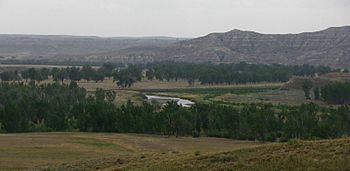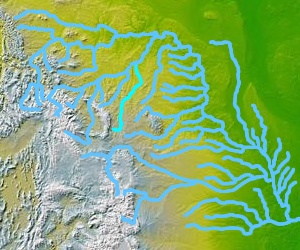Powder River (Wyoming and Montana) facts for kids
Quick facts for kids Powder River |
|
|---|---|

A view of the Powder River in northern Wyoming
|
|

Map of the Powder River basin
|
|
| Country | United States |
| State | Wyoming, Montana |
| Physical characteristics | |
| Main source | Confluence of Middle Fork and North Fork Near Kaycee, Wyoming 4,564 ft (1,391 m) 43°40′30″N 106°30′45″W / 43.67500°N 106.51250°W |
| River mouth | Yellowstone River Near Terry, Montana 2,241 ft (683 m) 46°44′00″N 105°26′02″W / 46.73333°N 105.43389°W |
| Length | 375 mi (604 km) |
| Basin features | |
| Basin size | 21,875 sq mi (56,660 km2) |
| Tributaries |
|
The Powder River is a long river in the western United States. It flows for about 375 miles (604 km) through northeastern Wyoming and southeastern Montana. This river is a major branch of the Yellowstone River.
The Powder River helps drain a large area of land. This area is known as the Powder River Basin. It is part of the Great Plains, which are wide, flat lands east of the Bighorn Mountains.
Contents
Where Does the Powder River Start?
The Powder River actually begins from three different streams. These are called forks. They are the North Fork, Middle Fork, and South Fork.
The Three Forks of the River
- The North Fork and Middle Fork start on the eastern side of the Bighorn Mountains.
- The South Fork begins on the southern side of the Bighorn Mountains. This is west of the city of Casper.
These three forks meet together near the town of Kaycee. This area is at the base of the Bighorn Mountains.
The Journey of the Powder River
After the forks join, the river flows north. It continues its path east of the Bighorn Mountains. Eventually, it crosses into the state of Montana.
Joining Other Rivers
Near the town of Broadus, another river joins the Powder River. This is the Little Powder River. The Powder River then flows on for about 50 miles (80 km). Finally, it empties into the Yellowstone River. This meeting point is near Miles City, Montana.
How the Powder River Got Its Name
The name "Powder River" comes from a special feature of its banks. The sand along some parts of the river looks like fine powder or dust. Both English speakers and local Native American groups gave the river this name because of this unique sandy appearance.
See also
 In Spanish: Río Powder para niños
In Spanish: Río Powder para niños

